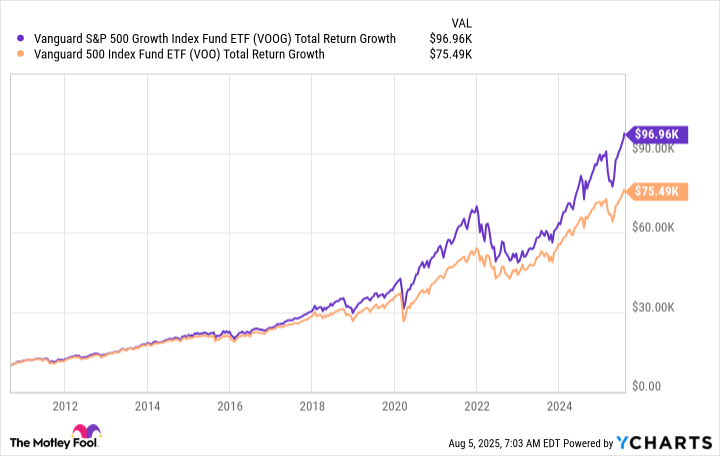Whether the market's in a strong bull position, like it is today, or pulling back, like it was doing earlier this year, it's always safe to have some strong exchange-traded funds (ETFs) in your portfolio. But when the market's going up, you'll typically see great movement in a growth-oriented ETF. Although you might see the inverse when the market's moving in the opposite direction, over time, growth ETFs tend to outdo the market, since the market rises more often than not.
However, you need to choose the right growth ETF to see the greatest gains and minimize your risk. Some growth ETFs have a small number of stocks and are risky, but others are well-diversified and hold the best the market has to offer. If you have $500 available to invest today, I recommend the Vanguard S&P 500 Growth ETF (VOOG +0.26%).
The cream of the crop
The Vanguard S&P 500 Growth ETF is an index-tracked ETF, which means it owns the same components as an underlying index. It tracks the stocks in the S&P 500 growth index, which are about 200 of the highest-growth stocks in the broader index. Because these are the growth-oriented stocks in the index, they also tend to be the largest stocks.
Like the S&P 500, the growth index is a weighted index, and the largest stocks account for a high percentage of the total. Nvidia, the largest position, accounts for 13.7%, and the next three, Microsoft, Meta Platforms, and Apple, account for more than 17% combined.

Image source: Getty Images.
For the most part, the 200 stocks in this ETF aren't the risky type of growth stocks, but the well-established industry giants that are still in growth mode. To be included in the S&P 500, stocks need a minimum market cap of $15.8 billion, leaving out young and risky upstarts, so "growth" here really refers to a very specific type of growth.
Some of the higher-weight stocks in the index include more secure stocks like Visa, JPMorgan Chase, Costco Wholesale, and Walmart.
High growth, low risk
Investing in the Vanguard S&P 500 Growth ETF gives shareholders exposure to new trends like artificial intelligence without putting all their eggs in one basket. And since the components change as the index changes, you decrease your risk of being exposed to stocks that are falling behind. If a stock falls below the minimum market cap threshold, it's removed from the index and replaced with a new stock.
You get all of that without having to pay for a fund manager to pick your stocks. Since most large-cap fund managers underperform the market in any given year, as is well-known, you also get to keep more of your money and enjoy better performance. The Vanguard S&P 500 Growth ETF's expense ratio is 0.07%, which it says is in contrast with an industry average of 0.93%.
Top performance over time
Since the market has historically been in growth mode more often than not, the Vanguard S&P 500 Growth ETF has outperformed the market over time. It was created the same day as the Vanguard S&P 500 ETF, but it has returned an annual average gain of 16.6%, versus 14.6% for the broader index ETF. Those two percentage points translate into a wide divergence over time, or about $10,000 for each point. If you'd invested $10,000 in each of those funds when they were launched, you'd have more than $20,000 extra from the Vanguard S&P 500 Growth ETF today.
VOOG Total Return Level data by YCharts.
If you're looking for a high-growth, low-risk ETF that has proven itself over time, consider the Vanguard S&P 500 Growth ETF.






